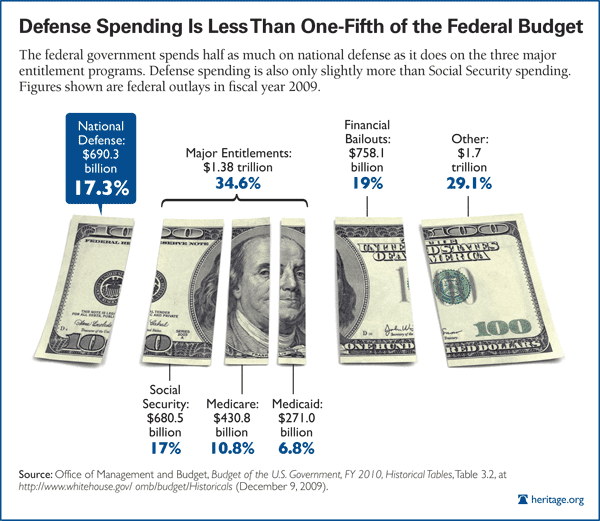THE ISSUE:
Today, every branch of America’s active duty military forces, as well as the National Guard and Reserves, are strained by the high level of operations that began in the 1990s. Despite the procurement holiday and dramatic defense budget cuts of the 1990s and the increasing investments since 2001, the demands on our forces are shortchanging their preparedness. Their wartime footing in Iraq and Afghanistan and the multi-theater war against terrorism, the economic downturn, and the rising costs of entitlements are forcing defense planners to make risky assumptions and trade-offs.
- National Defense Is a Constitutional Obligation. The U.S. Constitution directs the federal government first and foremost to provide for the common defense. Only fully equipped and modernized forces can assure this end.
- Compromising Core Missions Jeopardizes Security. America needs a force capable of fulfilling myriad core missions, from protecting our homeland and that of our allies to responding to disasters; ensuring freedom of air, space, sea, and cyberspace; helping our allies build their defense capacities to better partner with us if needed; and defeating enemies on their own territory so they cannot attack the U.S. with impunity. We cannot do this with smaller forces and outdated materiel.
- Military Equipment Is Aging Quickly. The major operations we undertook in 2001 after a decade of equipment and personnel cuts have aged our inventory of fighting vehicles, planes, and ships much more quickly than planned. Tactical aircraft are, on average, over 20 years old; B-1 Lancer bombers over 20; and KC-135 tankers about 44 years old. The U.S. must commit to modernizing its forces in the near term to ensure their ability to fulfill their missions and defend our interests in the future.
- Defense Spending Is Near Historical Lows. Defense spending came in at 38% of gross domestic product (GDP) during World War II; 14% in the Korean War; 10% during the Vietnam War, and 7% in the Cold War. Yet since 2001, it has averaged roughly 4% of GDP.
- Obama’s Defense Budgets Will Shrink Even Further. White House budget plans indicate defense budgets will fall as a percentage of GDP to a startling 3.01% in 2019.
- Defense Spending Is Not the Cause of America’s Fiscal Woes. Mandatory spending on entitlements and interest on our debt currently accounts for over 50% of the federal budget, while defense spending accounts for less than one-fifth.
THE SOLUTIONS:
- Adopt Sensible Defense Budgets. Eliminating waste is a worthy goal, but any funds achieved from efficiencies in defense operations must be reinvested in the military to offset the cost of modernizing and developing next-generation equipment. Real reform means fixing outdated, inefficient personnel compensation and business practices—not cutting troops and critical capabilities like missile defenses and fighter planes. By maintaining sensible and stable defense budgets and adopting better pay practices, we can find the funds for modernization and provide a steady stream of funding for new equipment with higher and more efficient production rates, economies of scale, and lower production costs.
- Modernize Logistics Systems. Currently, performance-based logistics partnerships between Department of Defense and defense industry personnel have helped increase our combat capabilities. The Aerospace Industries Association estimates that modernizing and expanding such performance-based logistics could save as much as $32 billion per year.
- Undertake Broader Acquisitions Reform. Congress should promote a wider reform agenda for acquisitions that includes restoring a systems engineering team approach, simplifying criteria, continuing competition well into the production phase, and carefully deregulating the defense market to remove barriers to entry and cut through the red tape that drives up costs.
- Build Partnerships and Capacity through Foreign Military Sales. We can achieve more efficient production rates and offset costs to U.S. taxpayers by further easing all the restrictions on sales of select platforms to our allies and partners. As a first step, the Senate should conclude the two pending treaties in this area with the United Kingdom and Australia, two of our most reliable allies.
- Stop Runaway Entitlement Spending. Social Security, Medicare, and Medicaid outlays consume 8.4% of GDP today; by 2030 that share is projected to surpass 14%. Should lawmakers allow entitlement spending to go unreformed, it will inevitably crowd out other categories of federal spending. Some will react by slashing future spending on our national security. For that reason, entitlement reform is essential if we are going to devote adequate resources to national security—the first and foremost responsibility of the federal government.

